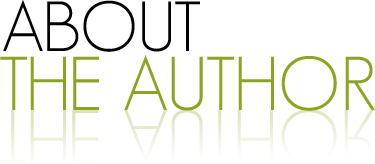The author bio is possibly the most important bit of back matter you can include in your book, which is why I’m devoting an entire post to it here. It can also be the most difficult thing you’ll ever write–which is why it’s useful to boil it down to the rule of three.
Long before you’ve published your first book, you should have a bio in the works. As an author, you are the brand your readers will be buying, and the bio is where readers can connect directly with that brand.
That all being said, your author bio, especially as it appears in your book, should be simple and short, but punchy. Too much information will overwhelm the casual reader. The interested reader will seek out more information about you if they so desire.
The rule of three, the idea that three is just the right number for brevity, pattern and rhythm, is a good one to apply to constructing your author bio. Pick three main things about you and work them together into a short paragraph. You’ll need different sized bios for different functions, which I’ll get to in a minute, but for the back of your book, the bio should be about 3-5 sentences long.
Here are three main categories of information you should include in your bio:
-
Information relating to your current writings
-
Your credentials as they pertain to the writings you are selling
-
Personal information that helps the reader feel connected to you
Sometimes it can be difficult to call to mind relevant details about yourself. For many writers, I think this is the hardest thing ever to write. We don’t want to sound full of ourselves, nor should we sound self-deprecating when we are trying to sell the reader on us as a brand. And often while we have no trouble imagining wild flights of fancy and fascinating characters, it can be difficult to mine the details that make us interesting human beings.
These are a few questions for each category that might help prompt the relevant information:
Your Writings: What have you written? How long have you been writing? What is your latest book? Are you writing a series? This category is particularly important because this is where readers can discover more about your brand. If you write various genres and series, you should couch the information here to pertain to the series or genre your book is related to.
Your Credentials: Do you have an educational background or life experience that pertains directly to the written work? Have you won any awards, or been mentioned by any major reviewers? Has your work been published anywhere notable? What have reviewers said about your work? Again, think in terms of what is relevant to this particular book and these particular readers. If your book is a romance but your best publication credit is in a horror magazine, it might be wise to use a different credential, like your background as a couples therapist.
Yourself: Where do you live? What pets do you have? Strange hobbies or habits? Favorite foods? Bizarre quirks? Significant life events? In this category, relevance is not as important as wit. This is usually where you’ll include the little twist or punch at the end of the bio that leaves a reader with a smile.
Once you’ve compiled a bunch of this kind of information about yourself, sit down and select just one item from each category. Try to select either the most relevant, or the most potent, or the most inter-related and/or varied bits of information.
Here’s an (entirely fictitious) example:
I’m writing an urban fantasy series called “Inner-City Fae.”
I’m an editor for the magazine Fairies Weekly.
I grew up in the inner city and my love of reading fairy stories kept me safe in books while drive-by shootings were going on outside.
Now translate the info into a bio, with a punchy ending:
Leticia Moonmoth is the author the urban fantasy series “Inner-City Fae,” a trilogy with two published works and one more on the way. She also works as an editor for Fairies Weekly, a magazine written for fairies by fairies. Moonmoth grew up in the inner city of Detroit, where she swears fairies once saved her from a drive-by shooting.
I generally suggest using the third person, especially for the version of your bio that will be included in your book. Even if you are self-publishing, it is the “publisher” you who is presenting the “author” you, like a host introducing you at a party. If you were being published in an anthology, for example, you certainly wouldn’t write your bio in first person. There are some situations where you do want your bio to be more intimate and conversational, and in those cases you can adapt it first person.
Your bio should be both timeless and evolving. Don’t use phrases like “ten years ago” because they will be incorrect within a year. However, you should be updating your various bios whenever certain things change. In the example above, when Leticia releases her third book, she might want to go back into the files of the first two and update her bio to reflect the fact that all three books are available and the series is completed.
Once you have this three-point bio, you can expand or shorten it to meet the needs you will have for bios in different venues.
Different Bios You Might Need:
-
Three word (or phrase) byline: Author, Editor, Blessed by fairies.
-
Twitter Bio (140 characters or less): Author of “Inner-City Fae” & editor of Fairies Weekly, written for fairies by fairies. Fairies once saved me from a drive-by in Detroit. (Notice the first person here–on social media, you are representing yourself, so no need to use third person.)
-
short bio (under 200 words): Leticia Moonmoth is the author of the urban fantasy series “Inner-City Fae,” a trilogy with two published works and one more on the way. She also works as an editor for Fairies Weekly, a magazine written for fairies by fairies. Moonmoth grew up in the inner city of Detroit, where she swears fairies once saved her from a drive-by shooting.
-
About the Author (500 words or less, for book jacket, website, media kit, etc. gives a little more than the short bios): Leticia Moonmoth is the author the urban fantasy series “Inner-City Fae,” a trilogy with two published works, “Uptown by Mothwing” and “Fairy Dust Dealer.” Book Three, “A Spell to Save Us,” will be released in November 2016. Moonmoth also works as an editor for Fairies Weekly, a magazine written for fairies by fairies. She grew up in the inner city of Detroit, where she swears fairies once saved her from a drive-by shooting. Follow her blog at moonmoth.com and learn more about the Inner-City Fae series at innercityfae.com. (The last bit might vary depending on the venue.)
-
Author history: This can be several paragraphs and can cover more detail about your life and times as a writer. This should probably only appear on your website for truly dedicated fans.



